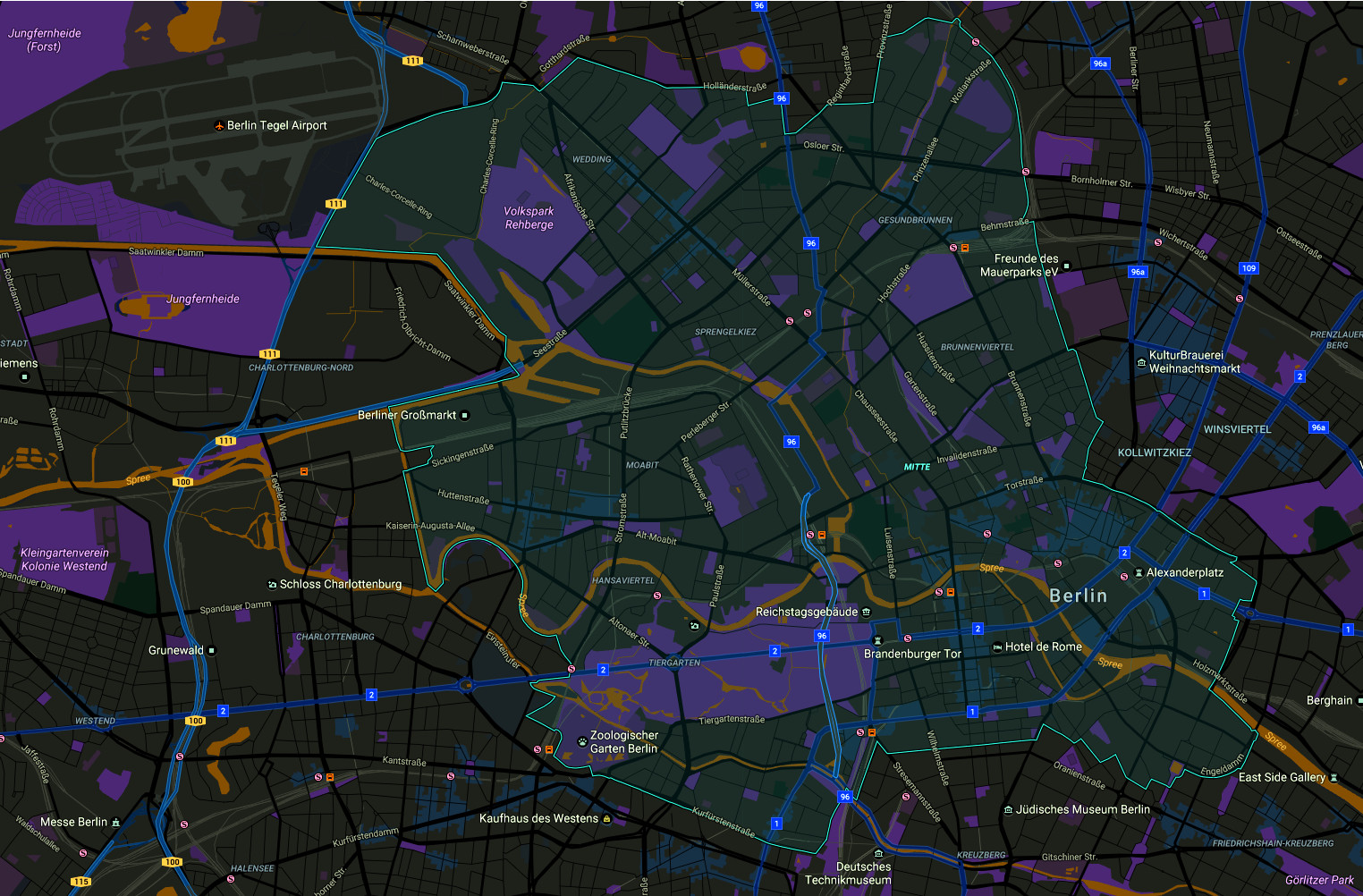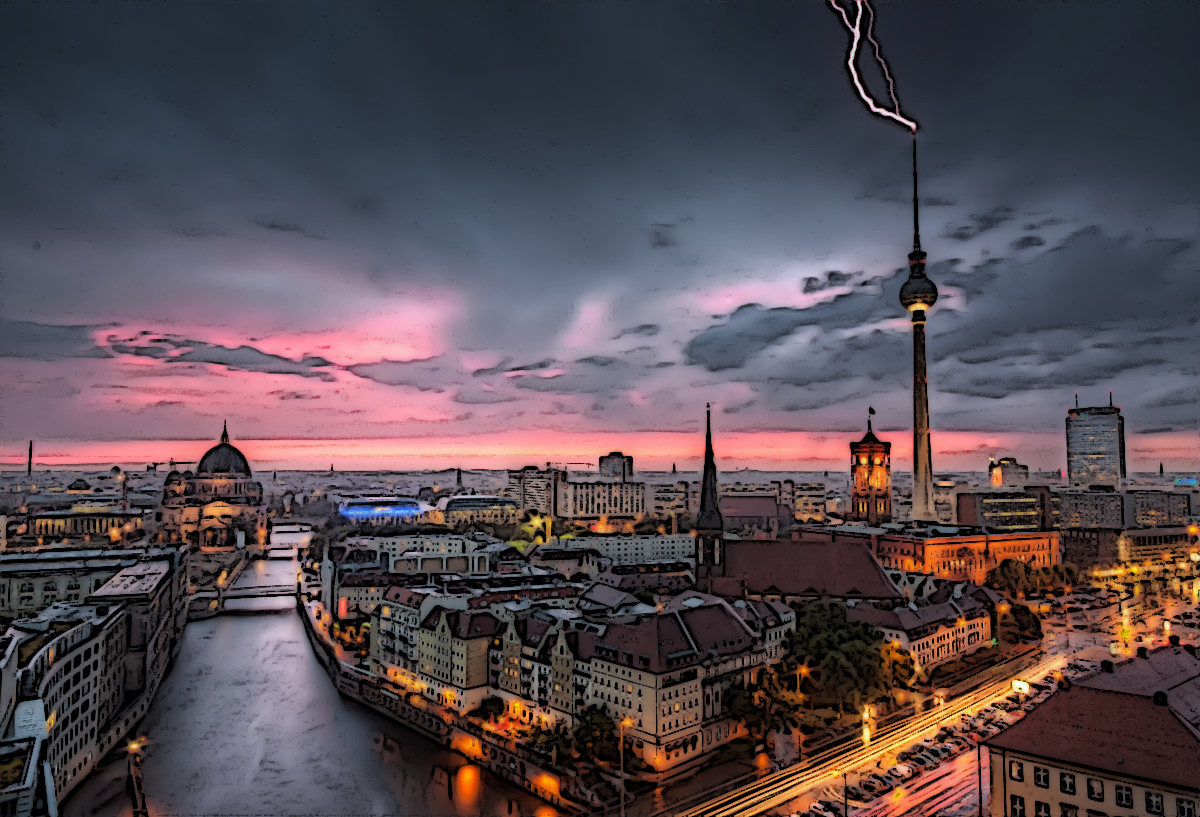Mitte: Difference between revisions
No edit summary |
No edit summary |
||
| (14 intermediate revisions by 2 users not shown) | |||
| Line 1: | Line 1: | ||
; | ;[[Berlin]] | ||
[[File:Berlin thunderstorm.jpg]] | |||
<br> | |||
<br> | |||
''' | == Pronunciation == | ||
(Mit-Eh) | |||
== Location == | |||
[[File:Berlin district Mitte.jpg]] | |||
<br> | |||
<br> | |||
Situated in central Berlin and mostly in its old town, it is traversed by the river Spree. It borders the localities of Tiergarten, Moabit, Wedding, Gesundbrunnen, Prenzlauer Berg (in Pankow district), Friedrichshain, and Kreuzberg (both in Friedrichshain-Kreuzberg district). | |||
== Description == | |||
== History == | |||
The history of Mitte corresponds to the history of the entire city until the early 20th century, and with the Greater Berlin Act in 1920 it became the first district of the city. It was among the areas of the city most heavily damaged in World War II. | |||
Following a territorial redeployment by the Soviet Union and the United Kingdom that reshaped the borders of West Berlin's British Sector in August 1945, the western part of Staaken became in effect as of 1 February 1951 an exclave of Mitte, then still a borough of East Berlin. This ended on January 1, 1961, when western Staaken was incorporated into then East German Falkensee, which had already been under its de facto administration since June 1, 1952. | |||
Between 1961 and 1990 Mitte, one of the most important boroughs of East Berlin but close to all three western sectors of the city, was almost surrounded by the Berlin Wall. One of the most important border crossings was Checkpoint Charlie, near Kreuzberg. | |||
== Culture == | |||
== Population == | |||
* 115,875 (2040 census) | |||
* 10,878/km2 | |||
== Burgomeister == | |||
* -- [[Gustav Breidenstein]] -- ''Prince of the East'' | |||
== Places of Interest == | |||
* -- [[Alexanderplatz]] --a large public square and transport hub in the central Mitte district of Berlin, near the Fernsehturm. Berliners often call it simply Alex, referring to a larger neighbourhood stretching from Mollstraße in the northeast to Spandauer Straße and the Rotes Rathaus in the southwest. | |||
* -- [[Berlin Hauptbahnhof]] -- Berlin's premier railway station. Located in Mitte. | |||
* -- [[Berliner Stadtschloss]] -- The Berlin City Palace was a royal and imperial palace in the center of Berlin, the historical capital of Prussia, and subsequently Germany. It was located on the Museum Island at Schlossplatz, opposite the Lustgarten park. It was the winter residence of the Kings of Prussia and the German Emperors. In 2013 work started on reconstruction and a part of the exterior of the palace has been rebuilt. The completion is expected in 2019. | |||
* -- [[Museum Island]] | |||
* -- [[Zoological Gardens of Berlin]] is the oldest and best known zoo in Germany. | |||
== Websites == | |||
<br> | |||
<br> | |||
Latest revision as of 21:50, 28 September 2016
Pronunciation
(Mit-Eh)
Location

Situated in central Berlin and mostly in its old town, it is traversed by the river Spree. It borders the localities of Tiergarten, Moabit, Wedding, Gesundbrunnen, Prenzlauer Berg (in Pankow district), Friedrichshain, and Kreuzberg (both in Friedrichshain-Kreuzberg district).
Description
History
The history of Mitte corresponds to the history of the entire city until the early 20th century, and with the Greater Berlin Act in 1920 it became the first district of the city. It was among the areas of the city most heavily damaged in World War II.
Following a territorial redeployment by the Soviet Union and the United Kingdom that reshaped the borders of West Berlin's British Sector in August 1945, the western part of Staaken became in effect as of 1 February 1951 an exclave of Mitte, then still a borough of East Berlin. This ended on January 1, 1961, when western Staaken was incorporated into then East German Falkensee, which had already been under its de facto administration since June 1, 1952.
Between 1961 and 1990 Mitte, one of the most important boroughs of East Berlin but close to all three western sectors of the city, was almost surrounded by the Berlin Wall. One of the most important border crossings was Checkpoint Charlie, near Kreuzberg.
Culture
Population
- 115,875 (2040 census)
- 10,878/km2
Burgomeister
- -- Gustav Breidenstein -- Prince of the East
Places of Interest
- -- Alexanderplatz --a large public square and transport hub in the central Mitte district of Berlin, near the Fernsehturm. Berliners often call it simply Alex, referring to a larger neighbourhood stretching from Mollstraße in the northeast to Spandauer Straße and the Rotes Rathaus in the southwest.
- -- Berlin Hauptbahnhof -- Berlin's premier railway station. Located in Mitte.
- -- Berliner Stadtschloss -- The Berlin City Palace was a royal and imperial palace in the center of Berlin, the historical capital of Prussia, and subsequently Germany. It was located on the Museum Island at Schlossplatz, opposite the Lustgarten park. It was the winter residence of the Kings of Prussia and the German Emperors. In 2013 work started on reconstruction and a part of the exterior of the palace has been rebuilt. The completion is expected in 2019.
- -- Museum Island
- -- Zoological Gardens of Berlin is the oldest and best known zoo in Germany.
Websites
